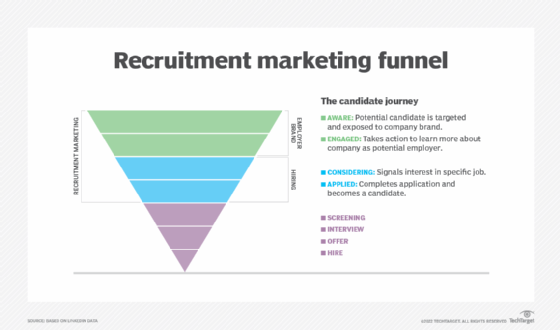9 keys to a killer recruitment marketing strategy
In a hiring market that presents unprecedented challenges, every HR and recruiting team needs to develop a marketing strategy to attract top-notch candidates. Here's how.
If you're an HR or recruiting leader in today's pandemic-challenged economy, you are well acquainted with the challenges of an improving U.S. employment rate and an unprecedented need to hire remote employees and rehire recently furloughed ones. It can seem impossible to fill all the open positions.
But new times call for new measures. Today's HR teams need to think like the ad agencies behind those killer tourism marketing campaigns -- only, in this case, the destination is your company. This approach to attracting candidates is called recruitment marketing, and it's a must for HR leaders and their talent acquisition and recruiting teams.
"Today, a recruiter can still blindly post a vacancy on job boards and hope that qualified applicants will come to them, but this style of 'post-and-pray' recruiting is unreliable," said Rachel Wytko, former vice president of strategic consulting at Marriott International.
A recruitment marketing strategy is a far more proactive approach to hiring.
"[A] recruitment marketing strategy is the approach you take to making your company's culture visible and attractive to top talent. It's a pull rather than push strategy," said Wences Garcia, general manager and head of culture at Marketgoo, a self-service SEO tools provider.
While there are plenty of ways to customize your recruitment marketing strategy, here are nine key steps for building the foundation.
1. Market your company as a talent destination
Going back to the analogy of tourism marketing tactics, you wouldn't expect a campaign to attract visitors to California to be the same as one to attract visitors to Iceland. Likewise, you'll need to market what makes your culture special. That takes care and attention.
"Companies need a way to differentiate themselves to potential team members that isn't trite and speaks directly to their ideal candidates," Garcia said.
To that end, Garcia said it's important to ask current employees what they love about working for the company. In addition, creating an internal culture-building team will help grow what's been built organically. That culture should be used as a selling point -- specifically in terms of matching ideal candidates with the culture, and more generally in terms of having a thought leader, preferably the CEO, who can speak to the media about your culture.
Earning a reputation for the great culture you build -- for example, through social media, traditional media outlets and sites such as Glassdoor -- is just as important. Part of that comes from empowering your employees to be your best brand ambassadors, Garcia said.
2. Refresh your social media mix
If your social media recruiting strategy is still focused on a handful of the expected channels, such as Facebook, LinkedIn and Twitter, it's time to hit refresh and add to the mix.
"Alternative social media considers sites like Mastodon and Gab instead of or beyond Twitter -- Dailymotion instead of YouTube. They're smaller but more niche, offer less competition and, by getting in early, there's a chance that you can go big as a major recruiter on the channel," said Dominika Albotova, former IT technical recruiter at PerceptionBox, based in Israel.
"Sponsoring podcasts and vlogs, whether on YouTube or Twitch, can be a very cost-effective alternative to other advertising options," Albotova added. She said some YouTube vlogger channels get hundreds of thousands of views or more but often have no sponsors. Vloggers can be reluctant to advertise products they don't know, but "offering jobs that fit a segment of their audience is a bonus for everyone." She said advertisers get 15-60 seconds of air time when the vlogger references their offerings and text, plus a web link in the vlog description.
Recruiters should also consider the increasingly popular video-sharing platform TikTok, especially if they want to engage candidates from younger generations.
3. Build and manage your talent pool
It takes several tools to manage a talent pool -- the most prominent likely being an applicant tracking system. Don't forget to tap into candidate records that are already in your database. Use those and more recent candidate files as a starting point for connecting with people, asking for referrals and developing market intelligence.
Further, collaborate with your marketing team to create a compelling career webpage that is aligned with your company branding and promotes brand awareness.
"To encourage people to speculatively apply and build up your talent pool, have clear instructions on how a candidate can register their interest. In a business that is scaling up, the careers page should be a distinct place for applicants to learn about the company, its values and current opportunities. It may also be worth investing in a company page on Glassdoor, Xing and LinkedIn," said Theresa Cantwell, director of people at Digiterre, a software and data engineering consultancy based in London.

4. Have an employee referral program
An employee referral program helps with both recruitment and retention. Referral candidates are usually good picks for the company, so the program ROI tends to be good. But these programs are also a great way of measuring employee satisfaction, which helps with employee retention efforts. If employees are referring friends and family, it means they value the company.
"Employees must be [made] aware of the referral program, so talk about it at new employee inductions, and mention the program whenever a new role is announced. Importantly, get feedback from employees about the program. Is the reward compelling? Would they refer people to the organization? We find anonymous culture engagement tools like Officevibe very useful in gauging employee sentiment and the [employee] Net Promotor Score," Cantwell said.
5. Understand the role of passive candidates
One of the main reasons traditional recruiting practices have lost their luster, Wytko said, is that the best talent may not be actively looking for work, given the low unemployment rate. The quest then becomes a matter of figuring out how to attract talent that is likely happily employed already.
Wytko warned that identifying passive candidates and making a job offer can fall flat, as that same person may be bombarded with numerous offers. Job advertisements also can come up short "if they fail to find [their] way to the places frequented by the potential applicant -- the communities, websites or social and mobile forums that cultivate large followings from people of common interests," she said. "That is where recruitment marketing strategies can help."
6. Know your ideal candidate persona
A good recruitment marketing strategy depends on your understanding of the candidates for any given job.
"Know what your ideal candidates want and aspire to, and create a target persona or a 'hiring avatar' reflecting these insights and your company needs as well," said Mads Hennelund, formerly an advisor for Danish consultancy Nextwork A/S.
In other words, to precisely target your efforts, you'll need to know who you are trying to recruit, where you're likely to find them and what they're likely to want out of a new job or career change.
"We pulled out a handful of core values about their work they enjoyed and turned that into the driving ad copy for the campaign," said Matt Lee, former director of marketing at Adhere Creative, a B2B digital marketing agency.
7. Use the job listing to magnetize candidates
Even in a candidate-driven market, job listings are a critical element of your recruitment marketing efforts. Candidates may check Glassdoor to see what your employees say about working at your company, check social media to see what your feeds say about your culture and turn to LinkedIn connections. But how you present the company and the job itself is likely to determine whether a potential candidate becomes an applicant. Bottom line: Don't miss out on the opportunity to sell.
"The way we handle it is that any job requirement goes through marketing," said Luís Magalhães, director of marketing at DistantJob, a remote recruitment company. "We try to market and sell our open positions to our candidates just as we market and sell our candidates to our clients."
"This means crafting a beautiful, sexy job description that inspires the potential employee reading it, challenging them but also providing an honest assessment of what it will be like to work on the position and why it will be great for them," Magalhães said.
8. Use the right tools to cultivate your talent supply
Candidates find career opportunities in traditional online and mobile venues, and those with in-demand skills can afford to be extremely selective about which opportunities they pursue. Make it easy for candidates to find you on their preferred channels -- such as social media outlets -- and make communication and applications easy to execute.
That means shorter applications enabled with easy, prefill fields -- and even using text messaging to recruit -- are smart moves.
"We implemented a 'text to apply' campaign, which was rather successful," Lee said. "More successful, however, was a short form on a landing page that got the application process started. We learned internal recruiters cared about only a handful of questions that deems [candidates] qualified or not for the job. We focused on those and got rid of the rest."
AI-enhanced tools can also make it faster and easier for you to find talent and for the candidate to have a great experience from the introduction to your company and going forward.
"For example, tools such as AI-driven candidate aggregators can automatically search digital sourcing channels to build intelligence about candidates in a fraction of the time required for human research," Wytko said.
"Also, algorithmic match models apply AI to connect potential candidates to opportunities by recognizing skills and competencies that truly apply to the open role," Wytko added. "Finally, new AI technologies can help to automate manual and administrative tasks in the process, enabling recruiters to focus on building relationships and driving a positive candidate experience."
9. Measure, measure, measure
In order to manage something well, you have to have reliable metrics to show the reality of the current status of your efforts.
"Ensure there are clearly defined and measurable goals to see if your marketing strategy is working," Wytko said. "Companies that enact purposeful recruitment marketing strategies and measure their results will be those that win the battle for top talent and retain them as champions and advocates for their brands."
Be sure to spend sufficient time on planning to flesh out the entire strategy before you start to implement it.
"To kick off a recruitment marketing strategy, you'll need to figure out who will be executing the process. Most think that recruitment activities will have to be conducted by one individual or team. But the truth is quite the opposite. If you can, a synergetic effort will be a lot more useful," said Charlie Worrall, digital marketing executive at Imaginaire Digital, a web design and digital marketing firm based in the U.K.







